Synoptic Conditions Generating Heat Waves and Warm Spells in Romania
Abstract
:1. Introduction
2. Experiments
2.1. Data Used
2.2. Methods
2.2.1. HWs and WSs Analysis
2.2.2. Synoptic Analysis
3. Results and Discussion
3.1. Synoptic Classification of HWs/WSs in Romania
3.1.1. Synoptic Conditions Generating Radiative HWs/WSs
3.1.2. Synoptic Conditions Generating Advective HWs/WSs
3.2. Frequency of HWs/WSs by Synoptic Conditions Types
3.3. Intensity Features of HWs/WSs Associated to Each Synoptic Type
3.3.1. The Radiative HWs Characteristics
3.3.2. The Advective HWs/WSs Characteristics
4. Conclusions
Acknowledgments
Author Contributions
Conflicts of Interest
References
- Huth, R.; Kysely, J.; Pokorna, L. A GCM simulation of heat waves, dry spells, and their relationships to circulation. Climatic Change 2000, 46, 29–60. [Google Scholar] [CrossRef]
- Beniston, M. The 2003 heat wave in Europe: A shape of things to come? An analysis based on Swiss climatological data and model simulations. Geophys. Res. Lett. 2004, 31, 202. [Google Scholar] [CrossRef]
- Meehl, G.; Tebaldi, C. More intense, more frequent, and longer lasting heat waves in the 21st century. Science 2004, 305, 994–997. [Google Scholar] [CrossRef] [PubMed]
- Schär, C.; Vidale, P.; Luthi, D.; Frei, C.; Haberli, C.; Liniger, M.; Appenzeller, C. The role of increasing temperature variability in European summer heatwaves. Nature 2004, 427, 332–336. [Google Scholar] [CrossRef] [PubMed]
- Stott, P.; Stone, D.; Allen, M. Human contribution to the European heatwave of 2003. Nature 2004, 432, 610–614. [Google Scholar] [CrossRef] [PubMed]
- Della-Marta, P.M.; Luterbacher, J.; von Weissenfluh, H.; Xoplaki, E.; Brunet, M.; Wanner, H. Summer heat waves over western Europe 1880–2003, their relationship to large-scale forcings and predictability. Clim. Dyn. 2007, 29, 251–275. [Google Scholar] [CrossRef]
- Coumou, D.; Rahmstorf, S. A decade of weather extremes. Nat. Clim. Change 2012, 2, 491–496. [Google Scholar] [CrossRef]
- Perkins, S.E.; Alexander, L.V. On the measurement of heat waves. J. Clim. 2013, 26, 4500–4517. [Google Scholar] [CrossRef]
- Peterson, T.C.; Heim, R.R., Jr.; Hirsch, R.; Kaiser, D.P.; Brooks, H.; Diffenbaugh, N.S.; Dole, R.M.; Giovannettone, J.P.; Guirguis, K.; Karl, T.R.; et al. Monitoring and understanding changes in heat waves, cold waves, floods, and droughts in the United States: State of knowledge. Bull. Amer. Meteor. Soc. 2013, 94, 821–834. [Google Scholar] [CrossRef]
- Keellings, D.; Waylen, P. Increased risk of heat waves in Florida: Characterizing changes in bivariate heat wave risk using extreme value analysis. Appl. Geogr. 2014, 46, 90–97. [Google Scholar] [CrossRef]
- Keggenhoff, I.; Elizbarashvili, M.; King, L. Heat wave events over Georgia since 1961: Climatology, changes and severity. Climate 2015, 3, 308–328. [Google Scholar] [CrossRef]
- Rusticucci, M.; Kyselý, J.; Almeira, G.; Lhotka, O. Long-term variability of heat waves in Argentina and recurrence probability of the severe 2008 heat wave in Buenos Aires. Theor. Appl. Climatol. 2016, 124, 679–689. [Google Scholar] [CrossRef]
- Croitoru, A.-E.; Piticar, A.; Ciupertea, A.F.; Roşca, C.F. Changes in heat waves indices in Romania over the period 1961–2015. Glob. Planet. Change 2016, 146, 109–121. [Google Scholar] [CrossRef]
- Pezza, A.-B.; van Rensch, P.; Cai, W. Severe heat waves in the Southern Australia: Synoptic climatology and large scale connections. Clim. Dyn. 2012, 38, 209–224. [Google Scholar] [CrossRef]
- Meehl, G.A.; Karl, T.; Easterling, D.R.; Changnon, S.; Pielke, R.J.; Changnon, D.; Evans, J.; Groisman, P.Y.; Knutson, T.R.; Kunkel, K.E.; et al. An introduction to trends in extreme weather and climate events: Observations, socioeconomic impacts, terrestrial ecological impacts, and model projections. Bull. Am. Meteorol. Soc. 2000, 81, 413–416. [Google Scholar] [CrossRef]
- Heatwaves: Risks and responses. Available online: http://www.euro.who.int/en/publications/abstracts/heat-waves-risks-and-responses (accessed on 27 September 2016).
- Managing the risks of extreme events and disasters to advance climate change adaptation. Available online: https://www.ipcc.ch/pdf/special-reports/srex/SREX_Full_Report.pdf (accessed on 27 September 2016).
- Radinović, D.; Ćurić, M. Criteria for heat and cold wave duration indexes. Theor.Appl. Climatol. 2012, 107, 505–510. [Google Scholar] [CrossRef]
- Giles, B.D.; Balafoutis, C.J. The Greek Heat Waves of 1987 and 1988. Int. J. Climatol. 1990, 10, 505–517. [Google Scholar] [CrossRef]
- Giles, B.D.; Balafoutis, C.; Maheras, P. Too hot for comfort: The heat waves in Greece in1987 and 1988. Int. J. Biometeorol. 1990, 34, 98–104. [Google Scholar] [CrossRef] [PubMed]
- Matzarakis, A.; Mayer, H. Heat stress in Greece. Int. J. Biometeorol. 1997, 41, 34–39. [Google Scholar] [CrossRef] [PubMed]
- Pantavou, K.; Theoharatos, G.; Nikolopoulos, G.; Katavoutas, G.; Asimakopoulos, D. Evaluation of thermal discomfort in Athens territory and its effect on the daily number of recorded patients at hospitals’ emergency rooms. Int. J. Biometeorol. 2008, 52, 773–778. [Google Scholar] [CrossRef] [PubMed]
- Dolney, T.J.; Sheridan, S.C. The relationship between extreme heat and ambulance response calls for the city of Toronto, Ontario, Canada. Environ. Res. 2006, 101, 94–103. [Google Scholar] [CrossRef] [PubMed]
- Fouillet, A.; Rey, G.; Laurent, F.; Pavillon, G.; Bellec, S.; Guihenneuc-Jouyaux, C.; Clavel, J.; Jougla, E.; Hémon, D. Excess mortality related to the August 2003 heatwave in France. Int. Arch. Occup. Environ. Health 2006, 80, 16–24. [Google Scholar] [CrossRef] [PubMed] [Green Version]
- Basu, R.; Samet, J.M. Relation between elevated ambient temperature and mortality: Are view of the epidemiologic evidence. Epidemiol. Rev. 2002, 24, 190–202. [Google Scholar] [CrossRef] [PubMed]
- Theoharatos, G.; Pantavou, K.; Mavrakis, A.; Spanou, G.-K.; Efsthatiou, P.; Mpekas, P.; Asimakopoulos, D. Heat waves observed in 2007 in Athens, Greece: Synoptic conditions, bioclimatological assessement, air quality levels and health effects. Environ. Res. 2010, 110, 152–161. [Google Scholar] [CrossRef] [PubMed]
- De Bono, A.; Giuliani, G.; Kluser, S.; Peduzzi, P. Impacts of summer 2003 heat wave in Europe. Eur. Environ. Alert. Bull. 2004, 2, 1–4. [Google Scholar]
- Russo, S.; Sillmann, J.; Fischer, E.M. Top ten European heatwaves since 1950 and their occurrence in the coming decades. Environ. Res. Lett. 2015, 10, 124003. [Google Scholar] [CrossRef]
- Colman, A. Prediction of summer central England temperature from preceding North Atlantic winter sea surface temperature. Int. J. Climatol. 1997, 17, 1285–1300. [Google Scholar] [CrossRef]
- Enfield, D.B.; Mestas-Nunez, A.M.; Trimble, P.J. The Atlantic multidecadal oscillation and its relation to rainfall and river flows in the continental US. Geophys. Res. Lett. 2001, 28, 2077–2080. [Google Scholar] [CrossRef]
- Kysely, J. Temporal fluctuations in heat waves at Prague-Klementinum, the Czech Republic, from 1901–1997, and their relationships to atmospheric circulation. Int. J. Climatol. 2002, 22, 33–50. [Google Scholar] [CrossRef]
- Cassou, C.; Terray, L.; Phillips, A.S. Tropical Atlantic Influence on European Heat Waves. J. Clim. 2005, 18, 2805–2811. [Google Scholar] [CrossRef]
- Sutton, R.T.; Hodson, D.L.R. Atlantic Ocean forcing of North American and European summer climate. Science 2005, 309, 115–118. [Google Scholar] [CrossRef] [PubMed]
- Nakamura, M.; Enomoto, T.; Yamane, S. A simulation study of the 2003 heatwave in Europe. J. Earth. Simul. 2005, 2, 55–69. [Google Scholar]
- Teng, H.; Branstator, G.; Wang, H.; Meehl, G.A.; Washington, W.M. Probability of US heat waves affected by a subseasonal planetary wave pattern. Nat. Geosci. 2013, 6, 1056–1061. [Google Scholar] [CrossRef]
- Tomczyk, A.M. Impact of atmospheric circulation on the occurrence of heat waves in southeastern Europe. Időjárás 2016, 120, 395–414. (In Magyar) [Google Scholar]
- Unkašević, M.; Tošić, I. An analysis of heat waves in Serbia. Glob. Planet. Change 2009, 65, 17–26. [Google Scholar] [CrossRef]
- Unkašević, M.; Tošić, I. Seasonal analysis of cold and heat waves in Serbia during the period 1949–2012. Theor. Appl. Climatol. 2015, 120, 29–40. [Google Scholar] [CrossRef]
- Brunner, L.; Hegerl, G.; Steiner, A. Connecting Atmospheric Blocking to European Temperature Extremes in Spring. J. Clim. 2017, 30, 585–594. [Google Scholar] [CrossRef]
- Leckebusch, G.C.; Ulbrich, U. On the relationship between cyclones and extreme windstorms over Europe under climate change. Glob. Planet. Change 2004, 44, 181–193. [Google Scholar] [CrossRef]
- Leckebusch, G.C.; Weimer, A.; Pinto, J.G.; Reyers, M.; Speth, P. Extreme wind storms over Europe in present and future climate: A cluster analysis approach. Meteorol. Z. 2008, 17, 67–82. [Google Scholar]
- Tomczyk, A.M.; Bednorz, E. Heat waves in Central Europe and their circulation conditions. Int. J. Climatol. 2016, 36, 770–782. [Google Scholar] [CrossRef]
- Kysely, J.; Domonkos, P. Recent increase in persistence of atmospheric circulation over Europe: Comparison with long-term variations since 1881. Int. J. Climatol. 2006, 26, 461–483. [Google Scholar] [CrossRef]
- Kysely, J. Implications of enhanced persistence of atmospheric circulation for the occurrence and severity of temperature extremes. Int. J. Climatol. 2007, 27, 689–695. [Google Scholar] [CrossRef]
- Kysely, J. Influence of the persistence of circulation patterns onwarm and cold temperature anomalies in Europe: Analysis over the 20th century. Glob. Planet. Change 2008, 62, 147–163. [Google Scholar] [CrossRef]
- Porebska, M.; Zdunek, M. Analysis of extreme temperature events in Central Europe related to high pressure blocking situations in 2001–2011. Meteorol. Z 2013, 22, 533–540. [Google Scholar]
- Donat, M.G.; Alexander, L.V.; Yang, H.; Durre, I.; Vose, R.; Robert, J.H.D.; Katharine, M.W.; Enric, A.; Manola, B.; Caesar, J.; et al. Updated analyses of temperature and precipitation extreme indices since the beginning of the twentieth century: The HadEX2 dataset. J. Geophys. Res. Atmos. 2013, 118, 2098–2118. [Google Scholar] [CrossRef]
- Spinoni, J.; Lakatos, M.; Szentimrey, T.; Bihari, Z.; Szalai, S.; Vogt, J.; Antofie, T. Heat and cold waves trends in Carpathian Region from 1961 to 2010. Int. J. Climatol. 2015, 35, 4197–4209. [Google Scholar] [CrossRef]
- Dragotă, C.-S.; Havriş, L.-E. Changes in Frequency, persistence and intensity of extreme high-temperature events in the Romanian Plain. In Proceedings of Air and water—Components of the Environment, Cluj, Romania, 20–22 March 2015.
- Huștiu, M.C. Cold and heat waves in the Barlad Plateau between 1961 and 2013. Riscuri şi Catastrofe 2016, 18, 31–42. [Google Scholar]
- Croitoru, A.-E.; Antonie, R.I.; Rus, A. Heat waves and their estimated socio-economic impact in Bucharest city, Romania. In Proceedings of the 14th International Multidisciplinary Scientific GeoConference SGEM2014, Sofia, Bulgaria, 7–26 June 2014; pp. 367–374.
- Papathoma-Koehle, M.; Promper, C.; Bojariu, R.; Cica, R.; Sik, A.; Perge, K.; Laszlo, P.; Balazs, C.E.; Dumitrescu, A.; Turcus, C.; et al. A common methodology for risk assessment and mapping for south-east Europe: An application for heat wave risk in Romania. Nat. Hazards 2016. [Google Scholar] [CrossRef]
- Croitoru, A.-E.; Piticar, A.; Burada, D.C. Changes in precipitation extremes in Romania. Quatern. Int. 2016, 415, 325–335. [Google Scholar] [CrossRef]
- Guide to Climatological Practices. Available online: http://www.wmo.int/pages/prog/wcp/ccl/guide/documents/WMO_100_en.pdf (accessed on 22 January 2017).
- Klein Tank, A.M.G.; Wijngaard, J.B.; Konnen, G.P.; Böhm, R.; Demaree, G.; Gocheva, A.; Mileta, M.; Pashiardis, S.; Hejkrilik, L.; Kern-Hansen, C.; et al. Daily dataset of 20th-century surface air temperature and precipitation series for the European climate assessment. Int. J. Climatol. 2002, 22, 1441–1453. [Google Scholar] [CrossRef]
- Dumitrescu, A.; Birsan, M.V. ROCADA: A gridded daily climatic dataset over Romania (1961–2013) for nine meteorological variables. Nat. Hazards 2015, 78, 1045–1063. [Google Scholar] [CrossRef]
- Stein, A.F.; Draxler, R.R.; Rolph, G.D.; Stunder, B.J.B.; Cohen, M.D.; Ngan, F. NOAA’s HYSPLIT atmospheric transport and dispersion modeling system. Bull. Amer. Meteor. Soc. 2015, 96, 2059–2077. [Google Scholar] [CrossRef]
- Real-time Environmental Applications and Display sYstem (READY). Available online: https://www.ready.noaa.gov/index.php (accessed on 16 October 2016).
- Ustrnul, Z.; Czekierda, D. Atlas of Extreme Meteorological Phenomena and Synoptic Situations in Poland; Instytut Meteorologii i Gospodarki Wodnej: Warszawa, Poland, 2009; pp. 1–182. [Google Scholar]
- Furrer, E.M.; Katz, R.W.; Walter, M.D.; Furrer, R. Statistical modeling of hot spells and heat waves. Clim. Res. 2010, 43, 191–205. [Google Scholar] [CrossRef]
- Croitoru, A.-E. Heat waves. Concept, definition and methods used to detect. Riscuri și Catastrofe 2014, XV(2), 25–32. [Google Scholar]
- Kyselý, J. Probability estimates of extreme temperature events: Stochastic.modelling approach vs. extreme value distributions. Stud. Geophys. Geod. 2002, 46, 93–112. [Google Scholar] [CrossRef]
- Kossowska-Cezak, U. Fale upałów i okresy upalne-metody ich wyróżniania i wyniki zastosowania. Prace Geograficzne 2010, 123, 143–149. (In Polski) [Google Scholar]
- Bobvos, J.; Fazekas, B.; Páldy, A. Assessment of heat-related mortality in Budapest from 2000 to 2010 by different indicators. Időjárás 2015, 119, 143–158. (In Magyar) [Google Scholar]
- Kuchcik, M.; Degórski, M. Heat- and cold-related mortality in the north-east of Poland as an example of the socio-economic effects of extreme hydrometeorological events in the Polish Lowland. Geographia Polonica. 2009, 82, 69–78. [Google Scholar] [CrossRef]
- Frich, P.; Alexander, L.V.; Della-Marta, P.; Gleason, B.; Haylock, M.; Klein Tank, A.M.G.; Peterson, T. Observed coherent changes in climatic extremes during 2nd half of the 20th century. Clim. Res. 2002, 19, 193–212. [Google Scholar] [CrossRef]
- Palecki, M.A.; Changnon, S.A.; Kunkel, K.E. The Nature and Impacts of the July 1999 heat wave in the Midwestern United States: Learning from the lessons of 1995. Bull. Am. Meteor. Soc. 2001, 82, 1353–1367. [Google Scholar] [CrossRef]
- Baldi, M.; Dalu, G.; Maracchi, G.; Pasqui, M.; Cesarone, F. Heatwaves in the Mediterranean: A local feature or a large scale effect? Int. J. Climatol. 2006, 26, 1477–1487. [Google Scholar] [CrossRef]
- Perkins, S.E.; Alexander, L.V.; Nairn, J.R. Increasing frequency, intensity and duration of observed global heatwaves and warm spells. Geophys. Res. Lett. 2012, 39, L20714. [Google Scholar] [CrossRef]
- Saha, S.; Moorthi, S.; Wu, X.; Wang, J.; Nadiga, S.; Tripp, P.; Behringer, D.; Hou, Y.-T.; Chuang, H.-Y.; Iredell, M.; et al. The NCEP Climate Forecast System Version 2. J. Clim. 2012, 27, 2185–2208. [Google Scholar] [CrossRef]
- Hansen, J.; Sato, M.; Ruedy, R. Perception of climate change. Proc. Natl. Acad. Sci. USA 2012. [Google Scholar] [CrossRef] [PubMed]
- Lee, Y.; Grotjahn, R. California Central Valley Summer Heat Waves Form Two Ways. J. Clim. 2016, 29, 1201–1217. [Google Scholar] [CrossRef]
- Stein, A.F.; Draxler, R.R.; Rolph, G.D.; Stunder, B.J.B.; Cohen, M.D. NOAA’s HYSPLIT Atmospheric Transport and Dispersion Modeling System. BAMS 2015. [Google Scholar] [CrossRef]
- Grumm, R. The central European and Russian heat event of July–August 2010. Bull. Am. Met. Soc. 2011. [Google Scholar] [CrossRef]
- Large Scale Extreme Events in Surface Temperature during 1950–2003: An Observational and Modeling Study. Available online: http://dl.acm.org/citation.cfm?id=1168779 (accessed on 15 November 2016).
- Feudale, L.; Shukla, J. Role of Mediterranean SST in enhancingthe European heat wave of summer 2003. Geophys. Res. Lett. 2007, 34, L03811. [Google Scholar] [CrossRef]
- Fischer, E.M.; Seneviratne, S.I.; Vidale, P.L.; Lüthi, D.; Schär, C. Soil moisture–Atmosphere interactions during the 2003 European summer heat wave. J. Clim. 2007, 20, 5081–5099. [Google Scholar] [CrossRef]
- Wang, W.W.; Zhou, W.; Li, X.Z.; Wang, X.; Wang, D.X. Synoptic-scale characteristics and atmospheric controls of summer heat waves in China. Clim. Dynam. 2016, 46, 2923–2941. [Google Scholar] [CrossRef]
- Lhotka, O.; Kysely, J. Hot central-European summer of 2013 in a long-term context. Int. J. Clim. 2015, 35, 4399–4407. [Google Scholar] [CrossRef]
- Kysely, J. Recent severe heat waves in central Europe: How to view them in a long-term prospect? Int. J. Clim. 2010, 30, 89–109. [Google Scholar] [CrossRef]
- Luterbacher, J.; Dietrich, D.; Xoplaki, E.; Grosjean, M.; Wanner, H. European seasonal and annual temperature variability, trends, and extremes since 1500. Science 2004, 303, 1499–1503. [Google Scholar] [CrossRef] [PubMed]
- Cowan, T.; Purich, A.; Perkins, S.; Pezza, A.; Boschat, G.; Sadler, K. More frequent, longer, and hotter heat waves for Australia in the twenty-first century. J. Clim. 2014, 27, 5851–5871. [Google Scholar] [CrossRef]
- Sandu, I.; Pescaru, V.I.; Poiana, I. Clima Romaniei; Editura Academiei Romane: București, Romania, 2008. [Google Scholar]
- Sfîcă, L.; Niță, A.; Iordache, I.; Ilie, N. Specific weather conditions on romanian territory for Hess-Brezowsky westerly circulation types. In Proceedings of the 15th International Multidisciplinary Scientific Geoconference SGEM2015, Albena Resort, Bulgaria, 18–24 June 2015.
- Black, E.; Blackburn, M.; Harison, G.; Hoskins, B.; Methven, J. Factors contributing to the summer 2003 heatwave. Weather 2004, 59, 217–223. [Google Scholar] [CrossRef]
- Fink, A.; Brucher, T.; Kruger, A.; Leckebusch, G.; Pinto, J.; Ulbrich, U. The 2003 European summer heatwaves and drought-synoptic diagnosis and impacts. Weather 2004, 59, 209–216. [Google Scholar] [CrossRef]
- Fischer, E.M.; Seneviratne, S.I.; Luthi, D.; Schär, C. Contribution of land-atmosphere coupling to recent European summer heat waves. Geophys. Res. Lett. 2007, 34, L06707. [Google Scholar] [CrossRef]
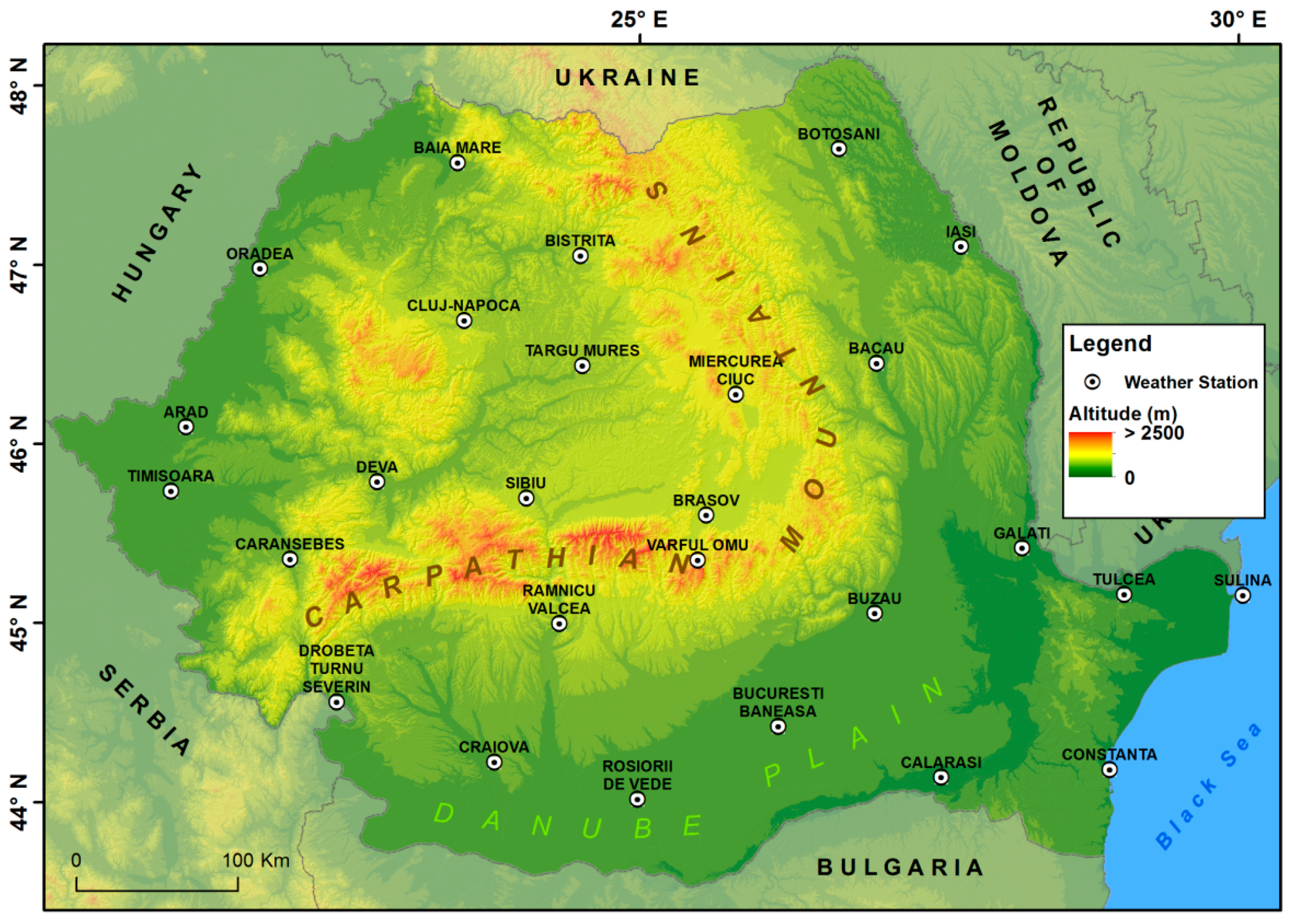
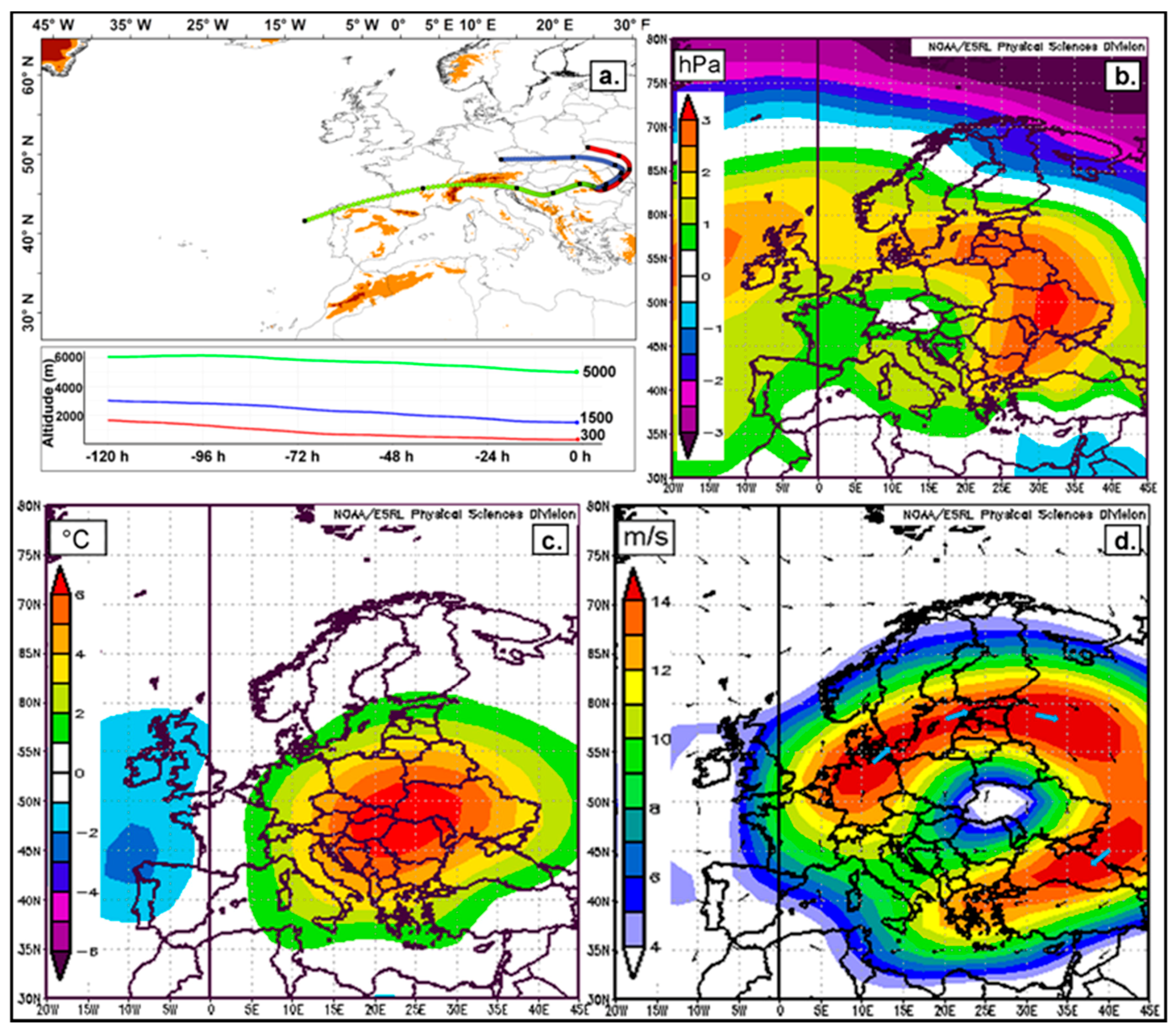
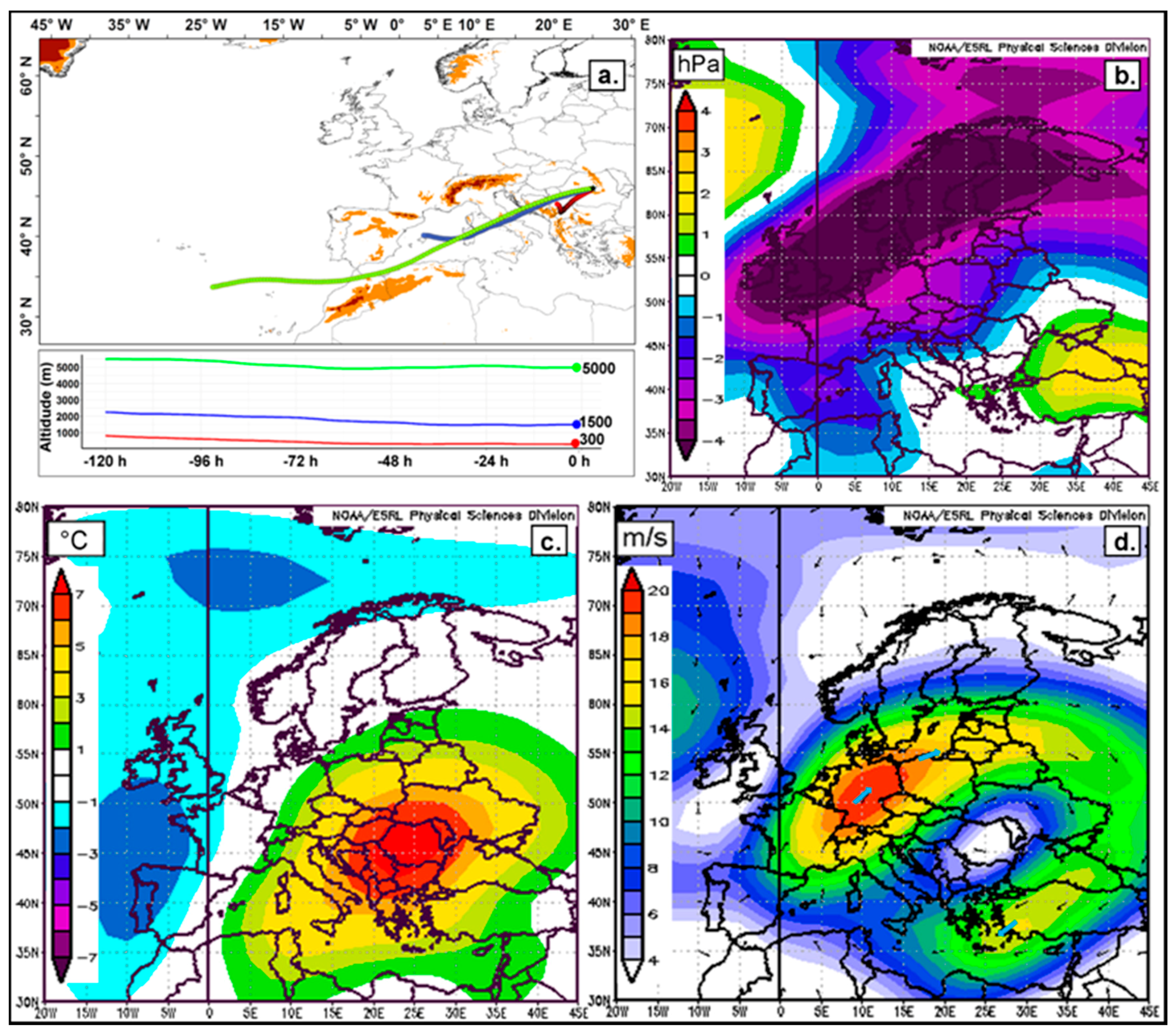
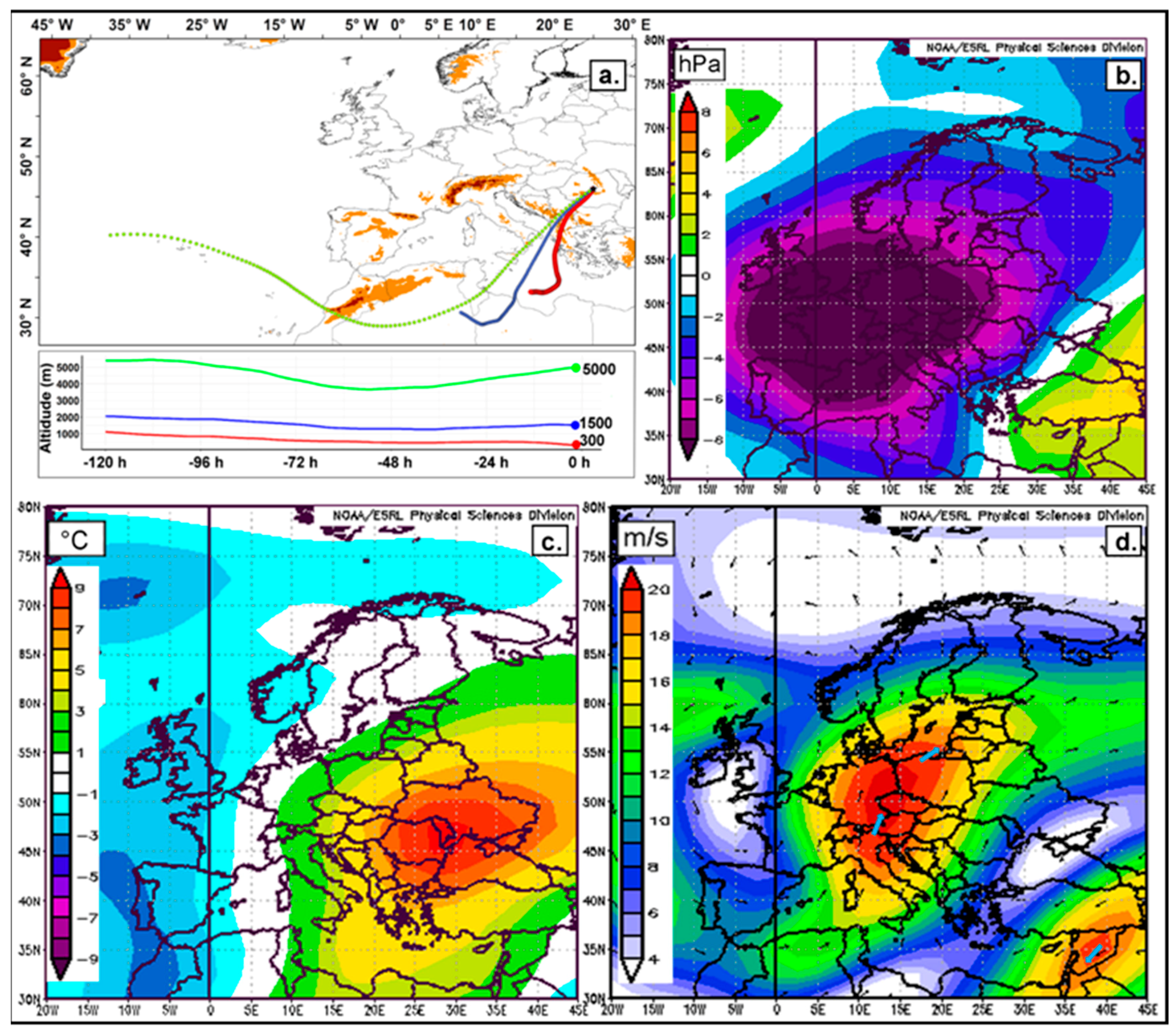
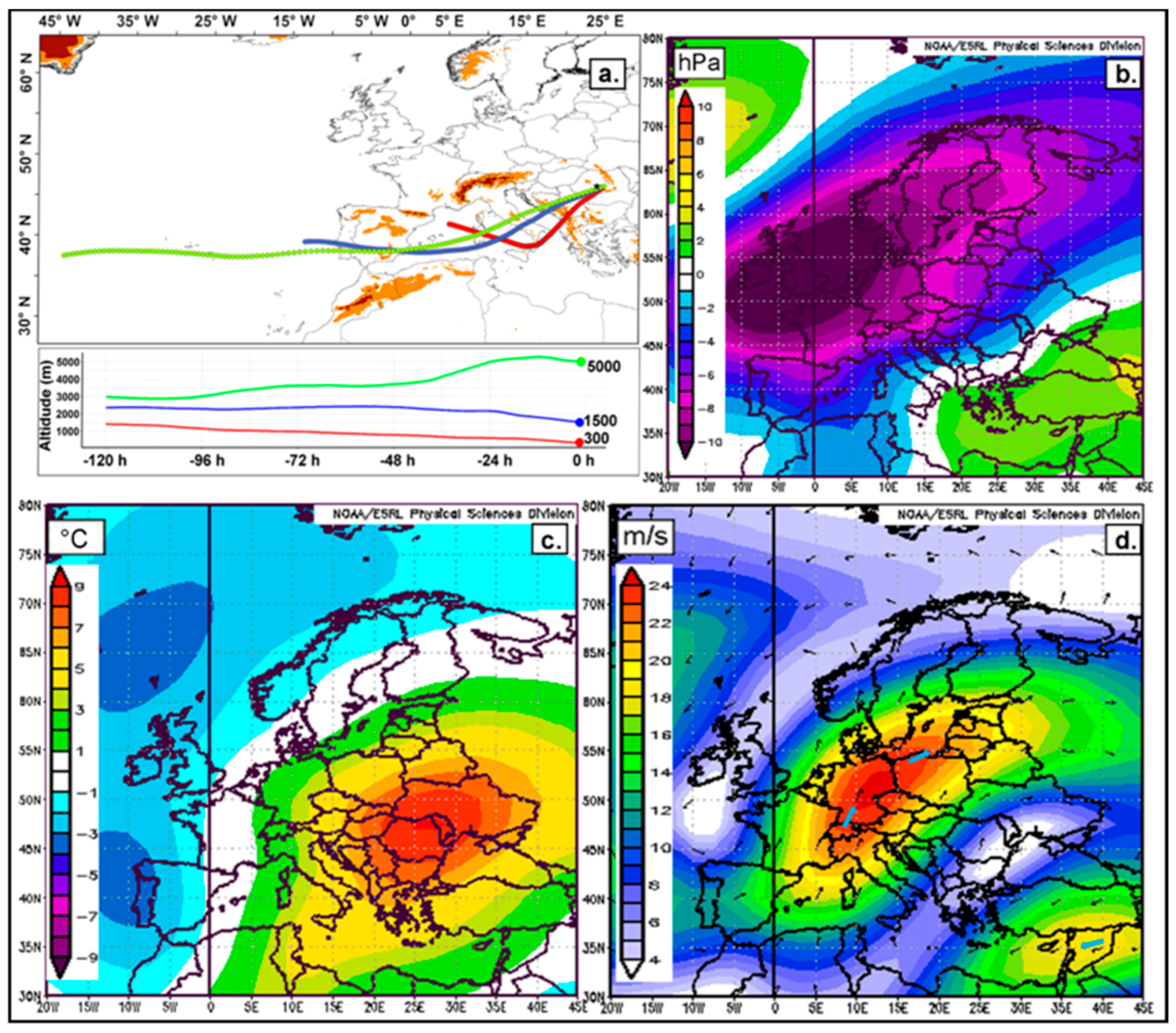
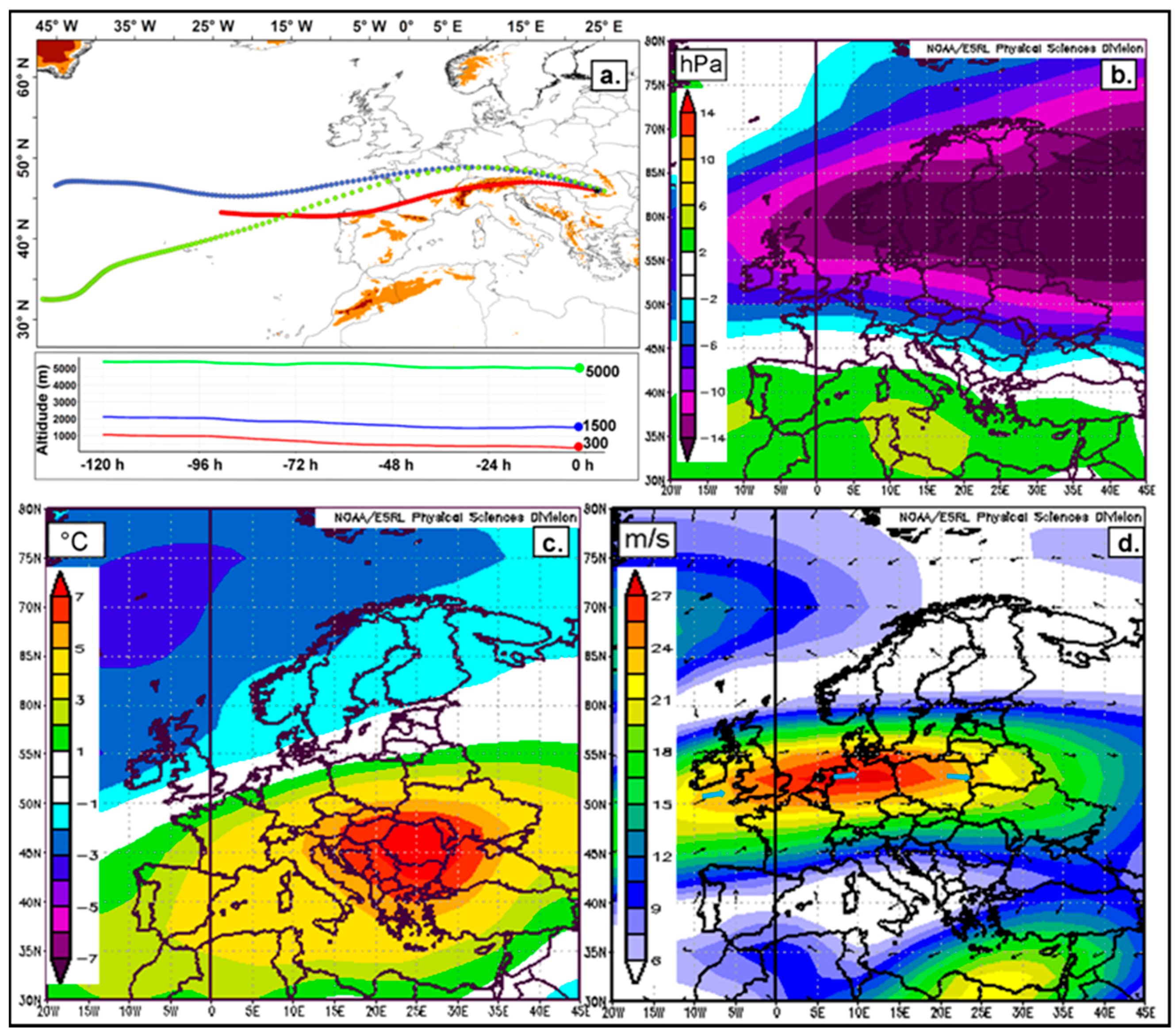
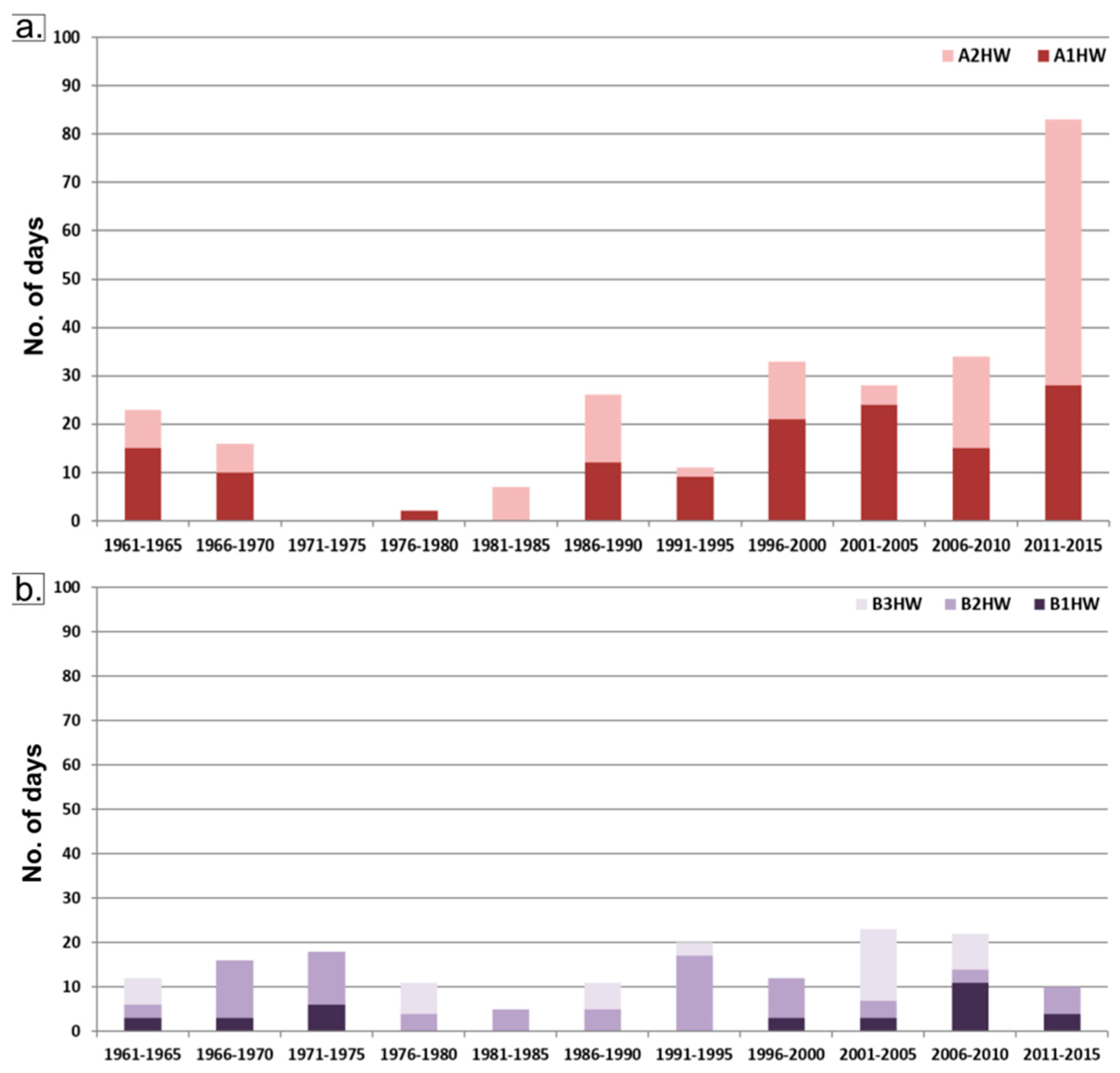

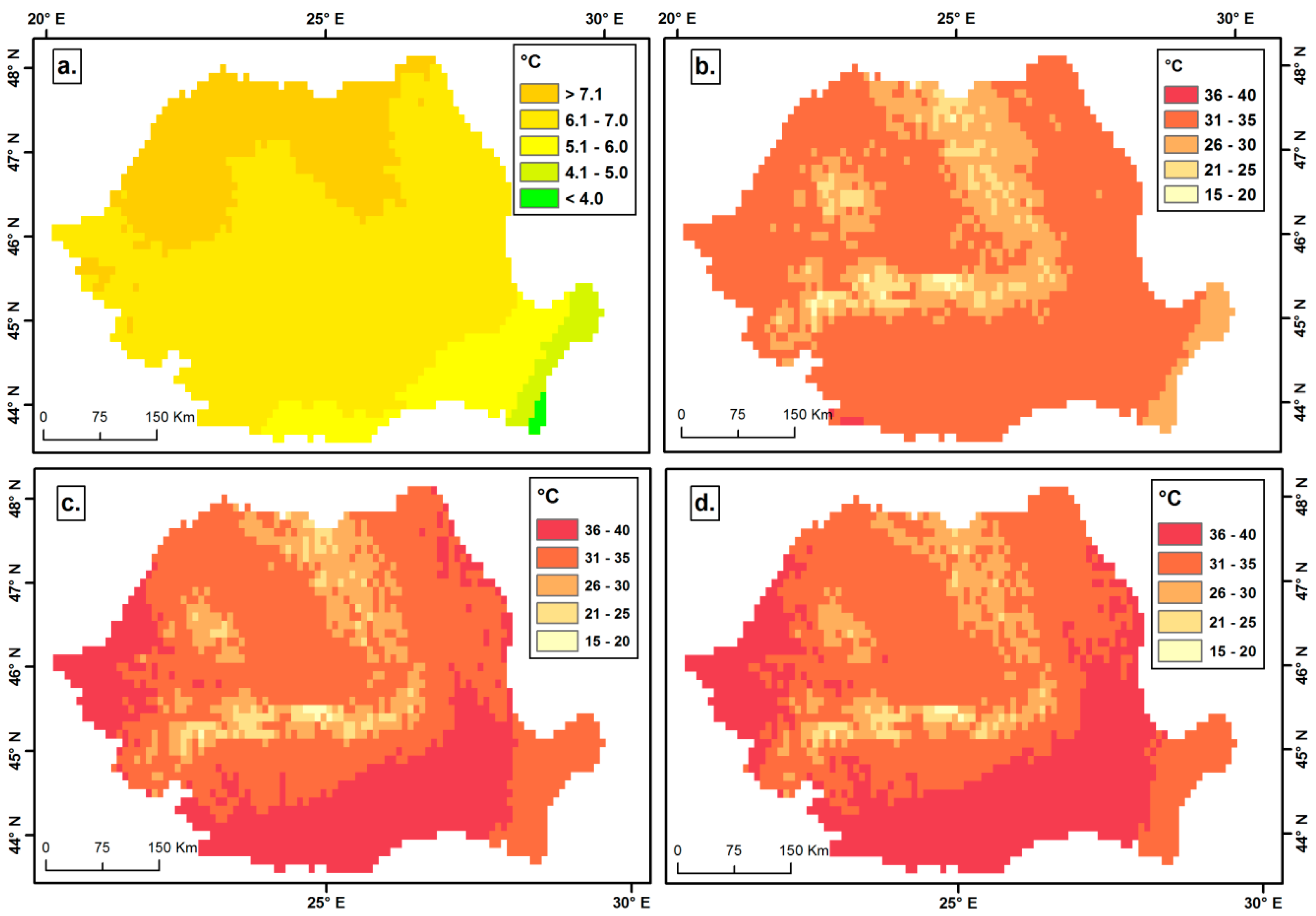
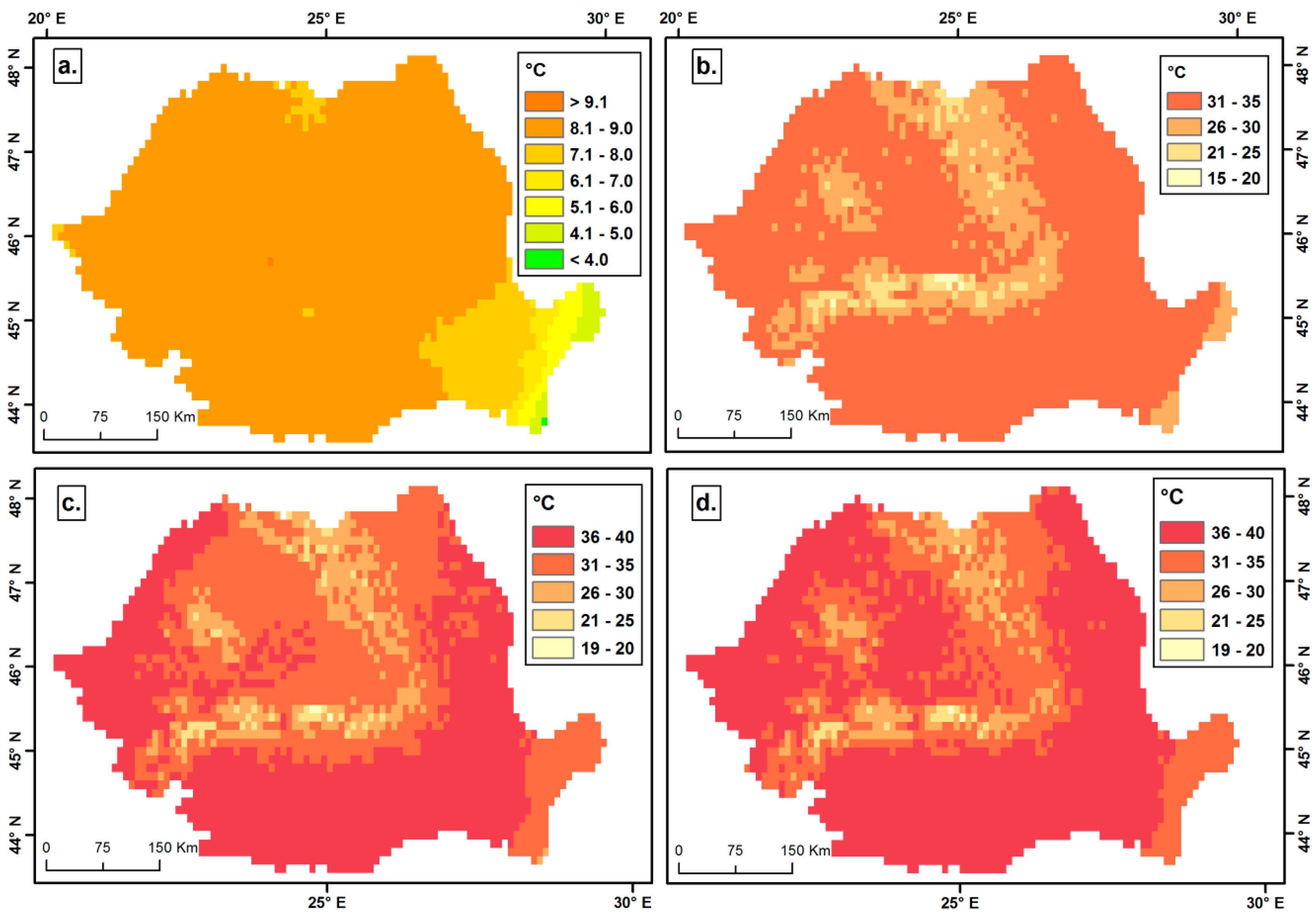
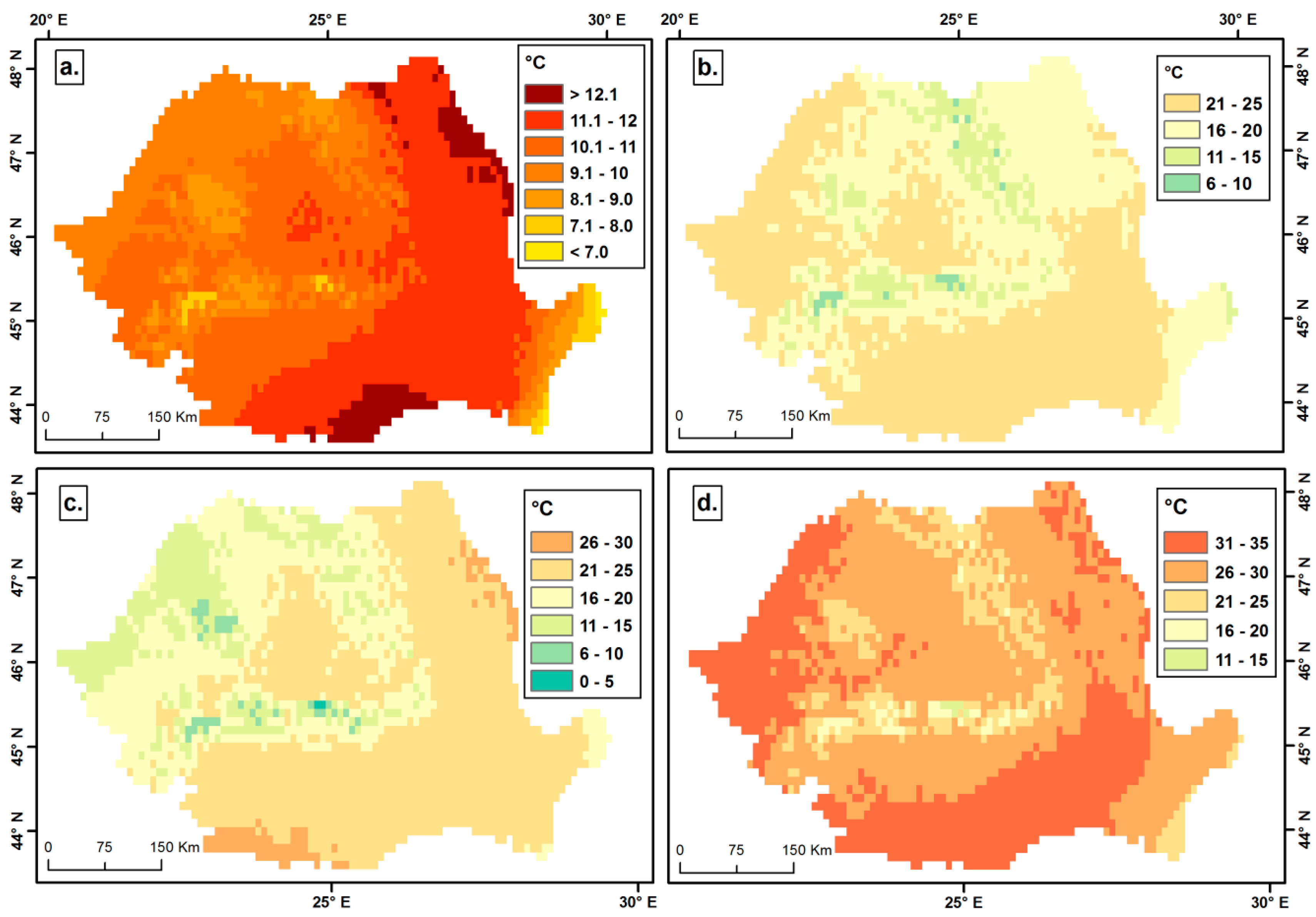
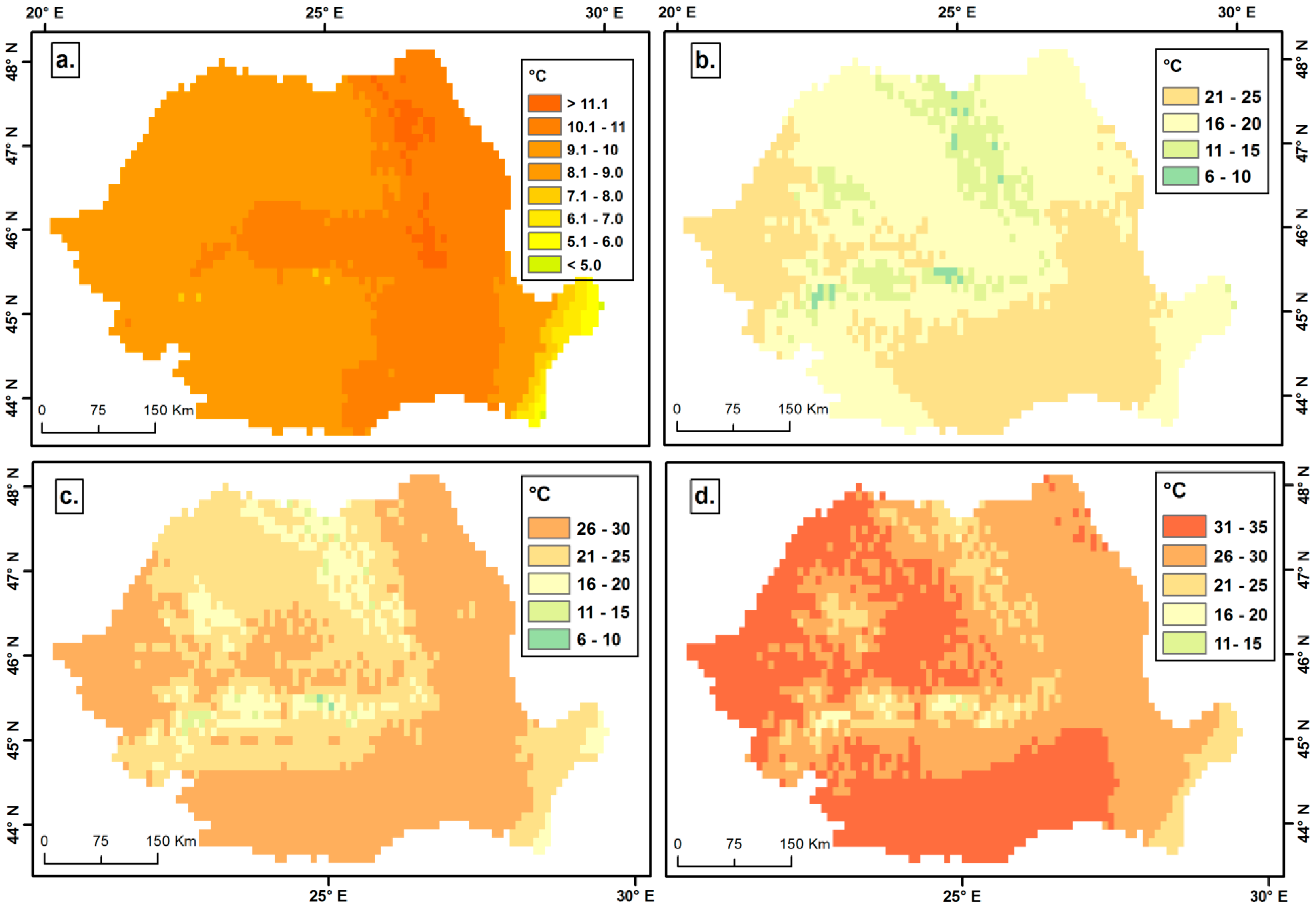
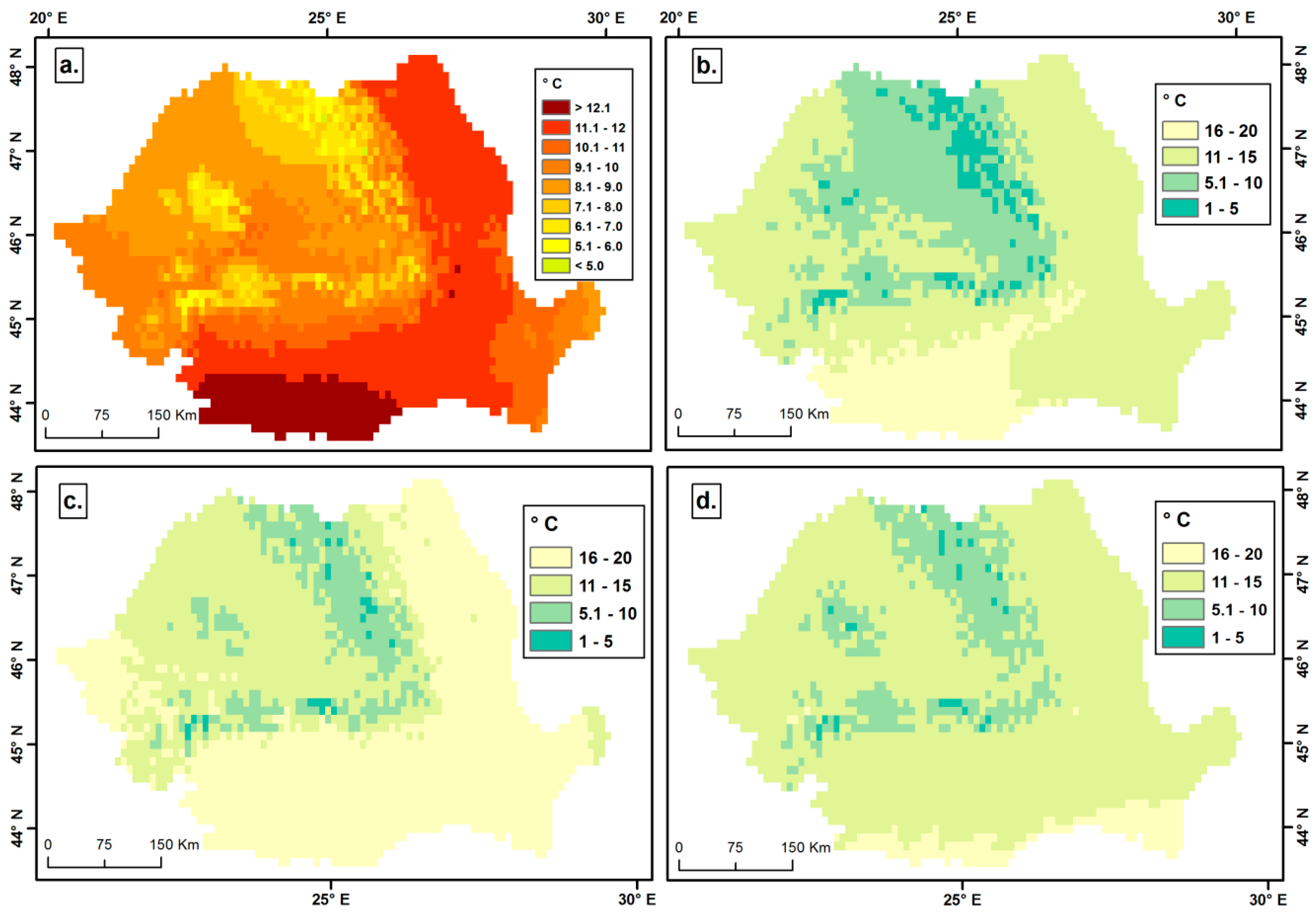
| No. | Station Name * | Latitude (N) | Longitude (E) | Altitude (m) | Missing Daily Data (%) |
|---|---|---|---|---|---|
| Western Romania | |||||
| 1. | Oradea | 47°02′10″ | 21°53′51” | 136 | 0.0 |
| 2. | Arad | 46°08′15″ | 21°21′13″ | 117 | 0.0 |
| 3. | Timisoara | 45°46′17″ | 21°15′35″ | 86 | 0.0 |
| 4. | Caransebes | 45°25′01″ | 22°13′30″ | 241 | 0.0 |
| Eastern Romania | |||||
| 5. | Botosani | 47°44′08″ | 26°38′40″ | 161 | 0.0 |
| 6. | Bacau | 46°31′54″ | 26°54′45″ | 184 | 0.0 |
| 7. | Iasi | 47°10′15″ | 27°37′42″ | 102 | 0.0 |
| 8. | Galati | 45°28′23″ | 28°01′56″ | 71 | 0.0 |
| Southern Romania | |||||
| 9. | Buzau | 45°07′57″ | 26°51′05″ | 97 | 0.0 |
| 10. | Ramnicu Valcea | 45°05′19″ | 24°22′45″ | 239 | 0.5 |
| 11. | Drobeta-Turnu Severin | 44°37′43″ | 22°37′33″ | 77 | 0.3 |
| 12. | Bucuresti Baneasa | 44°31′00″ | 26°05′00″ | 90 | 0.0 |
| 13. | Craiova | 44°18′36″ | 23°52′00″ | 192 | 0.0 |
| 14. | Calarasi | 44°12′22″ | 27°20′18″ | 19 | 0.0 |
| 15. | Rosiori de Vede | 44°06′26″ | 24°58′42″ | 102 | 0.0 |
| Central Romania | |||||
| 16. | Bistrita | 47°08′56″ | 24°30′49″ | 367 | 0.0 |
| 17. | Cluj-Napoca | 46°46′39″ | 23°34′17″ | 410 | 0.0 |
| 18. | Targu Mures | 46°32′01″ | 24°32′07″ | 317 | 0.0 |
| 19. | Deva | 45°51′52″ | 22°53′55″ | 230 | 0.0 |
| 20. | Sibiu | 45°47′21″ | 24°05′28″ | 444 | 0.0 |
| 21. | Brasov | 45°41′46″ | 25°31′40″ | 535 | 0.0 |
| Southwestern Romania | |||||
| 22. | Tulcea | 45°11′26″ | 28°49′26″ | 4 | 0.1 |
| 23. | Sulina | 45°02′26″ | 23°16′35″ | 3 | 0.2 |
| 24. | Constanta | 44°12′49″ | 28°38′41″ | 13 | 0.0 |
| Carpathians region | |||||
| 25. | Baia Mare | 47°39′40″ | 23°29′36″ | 224 | 0.0 |
| 26. | Miercurea Ciuc | 46°22′16″ | 25°46′21″ | 661 | 0.0 |
| 27. | Varful Omu | 45°26′45″ | 25°27′24″ | 2504 | 0.0 |
© 2017 by the authors. Licensee MDPI, Basel, Switzerland. This article is an open access article distributed under the terms and conditions of the Creative Commons Attribution (CC BY) license ( http://creativecommons.org/licenses/by/4.0/).
Share and Cite
Sfîcă, L.; Croitoru, A.-E.; Iordache, I.; Ciupertea, A.-F. Synoptic Conditions Generating Heat Waves and Warm Spells in Romania. Atmosphere 2017, 8, 50. https://doi.org/10.3390/atmos8030050
Sfîcă L, Croitoru A-E, Iordache I, Ciupertea A-F. Synoptic Conditions Generating Heat Waves and Warm Spells in Romania. Atmosphere. 2017; 8(3):50. https://doi.org/10.3390/atmos8030050
Chicago/Turabian StyleSfîcă, Lucian, Adina-Eliza Croitoru, Iulian Iordache, and Antoniu-Flavius Ciupertea. 2017. "Synoptic Conditions Generating Heat Waves and Warm Spells in Romania" Atmosphere 8, no. 3: 50. https://doi.org/10.3390/atmos8030050
APA StyleSfîcă, L., Croitoru, A.-E., Iordache, I., & Ciupertea, A.-F. (2017). Synoptic Conditions Generating Heat Waves and Warm Spells in Romania. Atmosphere, 8(3), 50. https://doi.org/10.3390/atmos8030050






